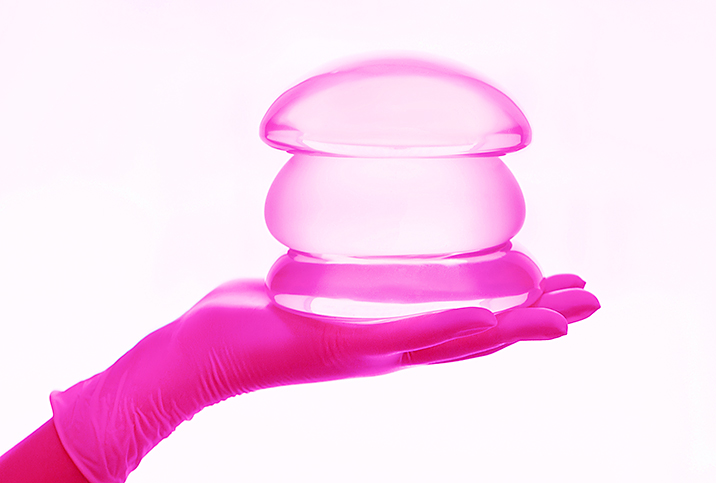Do Your Implants Put You at Risk for Breast Animation Deformity?

Breast implants have become increasingly popular in the last two decades for many reasons. They can boost self-esteem, improve confidence and correct asymmetry. But as with many procedures, there can be side effects. Depending on the position of your implants, you may be at a higher risk of animation deformity.
What is Breast Animation Deformity?
Breast animation deformity (aka BAD) is a common condition that can occur with breast augmentation and is believed to affect around 58 percent of patients who undergo submuscular implantation. While most women with breast implants will experience some level of animation deformity, it especially becomes a problem if it's severe and presents with pain and discomfort.
"Animation deformity is the displacement of the implant under the muscle when the muscle is engaged, usually causing implants to move to the sides and up and causing some dimpling on the breast," explained Olga Bachilo, M.D., a board-certified plastic surgeon at Glamour Plastic Surgery in Houston.
When submuscular implantation goes BAD(ly)
BAD is commonly associated with submuscular (also known as subpectoral or retropectoral) implantation. If you opt for submuscular placement, the implants will be placed below your pectoralis muscle.
According to Bachilo, there are a lot of advantages to this placement.
"Multiple studies indicate that submuscular placement of breast implants reduces the risk of capsular contracture, which is hardening of the breast," she said, adding that the benefits of this placement are a more natural result with a smoother upper breast slope which can reduce the risk of rippling.
Placing the implants below the muscle can also provide a better view of the breast tissue on mammography, according to Marc J. Salzman, M.D., a double board-certified aesthetic plastic surgeon in Louisville.
However, the downside to placing the implant below the pectoralis muscle is that in many cases there is a shift in the implant during the contraction of the muscle, which can typically occur during exercise.
"The disadvantages of a submuscular implant compared to either subglandular or subfascial are that it is more painful for the first few days, the implant can ride high in the pocket for a period of time up to a few weeks and the possibility of the animation deformity," Salzman said.
As a result of severe deformity, the implants can become distorted, which will not only affect the overall appearance but can cause serious discomfort in many women if not corrected.
Treating animation deformity
A severe case of BAD will need to be treated due to the significant impact it can have on a patient's health and well-being. One small study published in 2017 investigated the impact of animation deformity among 25 patients and indicated that 48 percent of patients felt it interfered with their daily life. If left untreated, the condition will only become worse.
Thankfully, animation deformity can be treated, but treatment options depend on its severity. Ultrasound can be a useful tool to help determine the severity of the deformity and assist with treatment options.
"While ultrasound cannot specifically diagnose the animation deformity, it can be used to help differentiate capsular contracture from incomplete pectoralis muscle division," Salzman explained. "It can be used to compare between sides of the chest wall, where the transition point on the medial aspect of the breast from the submuscular pocket as it changes to the subfascial or subglandular pocket."
According to Salzman, this analysis can help the surgeon to see if more muscle release will be necessary or whether enlarging the capsule will correct the issue. An ultrasound coupled with a physical exam can determine the level of deformity and determine the best method of fixing it. Mild deformity or rippling can be corrected with fat grafting, Bachilo said, which can improve the appearance and provide a more natural finish.
If the deformity is severe, alternative treatment options will be required.
"Severe animation can only be corrected by moving the implant above the muscle or removing the implant altogether and placing an autologous flap reconstruction," said Andrew Ashikari, M.D., a breast surgeon at Phelps Hospital, Northwell Health in Sleepy Hollow, New York.
Another option would be to "use an ADM such as Strattice to suture the bottom of the pectoralis muscle to the ADM and pull it down toward the inframammary crease," Salzman said. "This will better position the pectoralis muscle over the implant and prevent its retraction with animation."
Avoiding animation deformity
If you want to lower your risk of BAD, you may consider an alternative placement of breast implants.
"Prepectoral (above-muscle) implants have now become the trend, especially because of the use of ADMs (acellular dermal matrices), which can be placed between the skin and the implant and help protect the implant from eroding and ulcerating through the skin," Ashikari said. While this does often prevent animation deformity, it can cause rippling of the skin, which many people will wish to get corrected.
To help you find the best placement, discuss your concerns with your surgeon, who can talk you through the advantages and disadvantages of each option to help you make an informed decision. They will also discuss with you the options for corrective surgery should you opt for it.


















